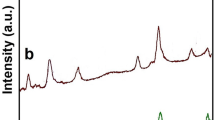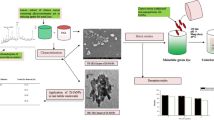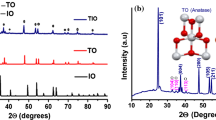Abstract
An iron(III)-polyvinyl chloride (PVC)-Schiff base adsorbent was prepared for removal of methyl orange (MO) as an anionic dye from the aqueous samples. PVC was reacted with ethylenediamine to prepare aminated PVC. Salicylaldehyde was then added to the aminated PVC to incorporate the Schiff base group into the polymer structure. This product was further reacted with iron (III) nitrate to form an iron complex as the modified PVC adsorbent (PVC-[Fe(EDA)(Sald)]). The prepared adsorbent was characterized by Fourier transform-infrared (FT-IR) spectroscopy, scanning electron microscopy (SEM), energy-dispersive X-ray spectroscopy (EDX), Brunauer-Emmett-Teller (BET) surface area analysis, and thermogravimetric analysis (TGA). The special parameters influencing the adsorption process such as the solution pH, contact time, initial dye concentration, and the solution temperature were investigated. Removal percentage (%R) and adsorption capacity (qt) greater than 50% and 140 mg g−1, respectively, were obtained under the following conditions: pH, 7;contact time, 150 min; dye concentration, 100 mg.L−1; and solution temperature, 25 °C. The adsorption isotherm and kinetic data were well fitted by the Freundlich isotherm model and the pseudo-second-order kinetic model, respectively. The thermodynamic data revealed that the adsorption process was endothermic and spontaneous. The changes in entropy (ΔS°) and enthalpy (ΔH°) were calculated to be 0.110 kJ mol−1 K−1 and 31.011 kJ mol−1, respectively. In this work, we developed for the first time the synthesis of an iron(III)-polyvinyl chloride (PVC)-Schiff base adsorbent that can be successfully used for removal of methyl orange from the aqueous sample. Furthermore, these findings showed that modified PVC was more efficient than neat PVC on MO removal for adsorption process.
















Similar content being viewed by others
References
Abd Alrazzak, N., Aowda, S. A., & Atiyah, A. J. (2017). Removal Bismarck Brown G dye from aqueous solution over a composite of triazole-polyvinyl chloride polymer and zinc oxide. Oriental Journal of Chemistry, 33(5), 2476–2483.
Abdolmaleki, A., Mallakpour, S., & Tabebordbar, H. (2017). Improvement of PVC / α -MnO 2 -LVA nanocomposites properties : A promising adsorbent for Pb ( II ) uptake (Vol. 5341). https://doi.org/10.1080/1023666X.2017.1404198.
Abdolmaleki, A., Mallakpour, S., & Tabebordbar, H. (2018). Improvement of PVC/α-MnO2–LVA nanocomposites properties: a promising adsorbent for Pb (II) uptake. International Journal of Polymer Analysis and Characterization, 23(2), 142–155.
Abdulraheem, G., Bala, S., Muhammad, S., & Abdullahi, M. (2015). Kinetics, equilibrium and thermodynamics studies of CI Reactive Blue 19 dye adsorption on coconut shell based activated carbon. International Biodeterioration & Biodegradation, 102, 265–273.
Abramian, L., & El-rassy, H. (2020). Adsorption kinetics and thermodynamics of azo-dye Orange II onto highly porous titania aerogel., 150(2009), 403–410. https://doi.org/10.1016/j.cej.2009.01.019.
Agcaoili, A. R., Herrera, M. U., Futalan, C. M., & Balela, M. D. L. (2017). Fabrication of polyacrylonitrile-coated kapok hollow microtubes for adsorption of methyl orange and Cu (II) ions in aqueous solution. Journal of the Taiwan Institute of Chemical Engineers, 78, 359–369.
Ahmad, M. A., & Alrozi, R. (2011). Removal of malachite green dye from aqueous solution using rambutan peel-based activated carbon: equilibrium, kinetic and thermodynamic studies. Chemical Engineering Journal, 171(2), 510–516.
Ai, L., Jiang, J., & Zhang, R. (2010). Uniform polyaniline microspheres: A novel adsorbent for dye removal from aqueous solution. Synthetic Metals, 160(7–8), 762–767.
Ali, H. M. A., Silva, C. V., Royer, B., Rodrigues Filho, G., Cerqueira, D. A., & Assunção, R. (2017). Chemically modified polyvinyl chloride for removal of thionine dye (Lauth’s violet). Materials, 10(11), 1298.
Al-zboon, K. K., Al-smadi, B. M., & Al-khawaldh, S. (2016). Natural volcanic tuff-based geopolymer for Zn removal: adsorption isotherm, kinetic, and thermodynamic study. Water, Air, & Soil Pollution. https://doi.org/10.1007/s11270-016-2937-5.
Arshadi, M., Faraji, A. R., Amiri, M. J., Mehravar, M., & Gil, A. (2015). Removal of methyl orange on modified ostrich bone waste–A novel organic–inorganic biocomposite. Journal of Colloid and Interface Science, 446, 11–23.
Ayawei, N., Ebelegi, A. N., & Wankasi, D. (2017). Modelling and Interpretation of Adsorption Isotherms, 2017.
Bertoni, F. A., González, J. C., García, S. I., Sala, L. F., & Bellú, S. E. (2018). Application of chitosan in removal of molybdate ions from contaminated water and groundwater. Carbohydrate Polymers, 180, 55–62.
Borsagli, F. G. L. M. (2019). A green 3D scaffolds based on chitosan with thiol group as a model for adsorption of hazardous organic dye pollutants, 169, 24709. https://doi.org/10.5004/dwt.2019.24709.
Borsagli, F. G. L. M., Carvalho, I. C., & Mansur, S. (2018). PT, (2017), #pagerange#. https://doi.org/10.1016/j.ijbiomac.2018.03.133.
Crini, G. (2006). Non-conventional low-cost adsorbents for dye removal: a review. Bioresource Technology, 97(9), 1061–1085.
Deligeer, W., Gao, Y. W., & Asuha, S. (2011). Adsorption of methyl orange on mesoporous γ-Fe2O3/SiO2 nanocomposites. Applied Surface Science, 257(8), 3524–3528.
Dockal, E. R. (2005). Synthesis and characterization of Schiff bases from chitosan and salicylaldehyde derivatives, 60, 277–282. https://doi.org/10.1016/j.carbpol.2004.12.008.
Edition, I. (2008). Zinc ( II ) complexes with Schiff bases derived from ethylenediamine and salicylaldehyde : the synthesis and photoluminescent properties. 57(9), 1880–1889.
El-Gamal, S. M. A., Amin, M. S., & Ahmed, M. A. (2015). Removal of methyl orange and bromophenol blue dyes from aqueous solution using Sorel’s cement nanoparticles. Journal of Environmental Chemical Engineering, 3(3), 1702–1712.
Esther, F., Tibor, C., & Gyula, O. (2004). Removal of synthetic dyes from wastewaters: a review. Environment International, 30(7), 953–971.
Gupta, V. K., Singh, P., & Rahman, N. (2004). Adsorption behavior of Hg (II), Pb (II), and Cd (II) from aqueous solution on Duolite C-433: a synthetic resin. Journal of Colloid and Interface Science, 275(2), 398–402.
Habiba, U., Siddique, T. A., Talebian, S., Lee, J. J. L., Salleh, A., Ang, B. C., & Afifi, A. M. (2017). Effect of deacetylation on property of electrospun chitosan/PVA nanofibrous membrane and removal of methyl orange, Fe (III) and Cr (VI) ions. Carbohydrate Polymers, 177, 32–39.
Habiba, U., Siddique, T. A., Lee, J. J. L., Joo, T. C., Ang, B. C., & Afifi, A. M. (2018). Adsorption study of methyl orange by chitosan/polyvinyl alcohol/zeolite electrospun composite nanofibrous membrane. Carbohydrate Polymers, 191, 79–85.
Hao, O. J., Kim, H., & Chiang, P.-C. (2000). Decolorization of wastewater. Critical Reviews in Environmental Science and Technology, 30(4), 449–505.
Huang, J.-H., Huang, K.-L., Liu, S.-Q., Wang, A.-T., & Yan, C. (2008). Adsorption of Rhodamine B and methyl orange on a hypercrosslinked polymeric adsorbent in aqueous solution. Colloids and Surfaces A: Physicochemical and Engineering Aspects, 330(1), 55–61.
Jalil, A. A., Triwahyono, S., Adam, S. H., Rahim, N. D., Aziz, M. A. A., Hairom, N. H. H., et al. (2010). Adsorption of methyl orange from aqueous solution onto calcined Lapindo volcanic mud. Journal of Hazardous Materials, 181(1–3), 755–762.
Jawad, A. H., Mamat, N. F. H., Hameed, B. H., & Ismail, K. (2019). Journal of Environmental Chemical Engineering Biofilm of cross-linked Chitosan-Ethylene Glycol Diglycidyl Ether for removal of Reactive Red 120 and Methyl Orange: Adsorption and mechanism studies, 7(November 2018).
Karagianni, E., & Xenidis, A. (2020). Enhanced Hg removal from aqueous streams by sulfurized activated carbon products: Equilibrium and kinetic studies.
Katheresan, V., Kansedo, J., & Lau, S. Y. (2018). Efficiency of various recent wastewater dye removal methods: a review. Journal of Environmental Chemical Engineering, 6(4), 4676–4697.
Kim, M. H., Hwang, C.-H., Kang, S. B., Kim, S., Park, S. W., Yun, Y.-S., & Won, S. W. (2015). Removal of hydrolyzed Reactive Black 5 from aqueous solution using a polyethylenimine – polyvinyl chloride composite fiber. Chemical Engineering Journal, 280, 18–25. https://doi.org/10.1016/j.cej.2015.05.069.
Kumar, S., & Abdel-fattah, T. M. (2016). Kinetics , isotherm , and thermodynamic studies of the adsorption of reactive red 195 A dye from water by modified Switchgrass Biochar adsorbent. Journal of Industrial and Engineering Chemistry. https://doi.org/10.1016/j.jiec.2016.03.020.
Kumar, T. H. V., Sivasankar, V., Fayoud, N., Oualid, H. A., & Sundramoorthy, A. K. (2018). Synthesis and characterization of coral-like hierarchical MgO incorporated fly ash composite for the effective adsorption of azo dye from aqueous solution. Applied Surface Science, 449, 719–728.
Lafi, R., & Hafiane, A. (2016). Removal of methyl orange (MO) from aqueous solution using cationic surfactants modified coffee waste (MCWs). Journal of the Taiwan Institute of Chemical Engineers, 58, 424–433.
Léon, J. J. L., & De Matos, T. N. (2018). Elucidation of mechanism involved in adsorption of Pb ( II ) onto lobeira fruit (Solanum lycocarpum) using Langmuir, Freundlich and Temkin isotherms. Microchemical Journal, 137, 348–354. https://doi.org/10.1016/j.microc.2017.11.009.
Li, Y., Gao, H., Wang, C., Zhang, X., & Zhou, H. (2018a). One-step fabrication of chitosan-Fe (OH) 3 beads for efficient adsorption of anionic dyes. International Journal of Biological Macromolecules, 117, 30–41.
Li, X., Zhou, M., Jia, J., & Jia, Q. (2018b). A water-insoluble viologen-based β-cyclodextrin polymer for selective adsorption toward anionic dyes. Reactive and Functional Polymers, 126, 20–26.
Lian, F., Liu, C., Li, G.-G., Liu, Y.-F., Li, Y., & Zhu, L.-Y. (2012). Adsorption and desorption of dyes by waste-polymer-derived activated carbons. Huan Jing ke Xue= Huanjing Kexue, 33(1), 147–155.
Limousin, G., Gaudet, J.-P., Charlet, L., Szenknect, S., Barthes, V., & Krimissa, M. (2007). Sorption isotherms: A review on physical bases, modeling and measurement. Applied Geochemistry, 22(2), 249–275.
Manuscript, A. (2017). Materials Chemistry A. https://doi.org/10.1039/C7TA00389G.
Medeiros, F. G. L., Ciminelli, V. S. T., Ladeira, C. L., Haas, D. J., Lage, A. P., & Mansur, H. S. (2019). Journal of Environmental Chemical Engineering Multi-functional eco-friendly 3D scaffolds based on N- acyl thiolated chitosan for potential adsorption of methyl orange and antibacterial activity against Pseudomonas aeruginosa. Journal of Environmental Chemical Engineering, 7(5), 103286. https://doi.org/10.1016/j.jece.2019.103286.
Mittal, A., Malviya, A., Kaur, D., Mittal, J., & Kurup, L. (2007). Studies on the adsorption kinetics and isotherms for the removal and recovery of Methyl Orange from wastewaters using waste materials. Journal of Hazardous Materials, 148(1–2), 229–240.
Mladenova, R., Ignatova, M., Manolova, N., & Petrova, T. (2002). Preparation , characterization and biological activity of Schiff base compounds derived from 8-hydroxyquinoline-2-carboxaldehyde and Jeffamines ED â, 38, 989–999.
Mohammad, A., Saud, A., & Jawad, A. H. (2019). International Journal of Biological Macromolecules Box-Behnken design to optimize the synthesis of new crosslinked chitosan-glyoxal/TiO 2 nanocomposite: Methyl orange adsorption and mechanism studies. International Journal of Biological Macromolecules, 129, 98–109. https://doi.org/10.1016/j.ijbiomac.2019.02.025.
Qiu, H., Lv, L., Pan, B., Zhang, Q., Zhang, W., & Zhang, Q. (2009). Critical review in adsorption kinetic models. Journal of Zhejiang University-Science A, 10(5), 716–724.
Robinson, T., McMullan, G., Marchant, R., & Nigam, P. (2001). Remediation of dyes in textile effluent: A critical review on current treatment technologies with a proposed alternative. Bioresource Technology, 77(3), 247–255.
Sen, S. K., Raut, S., Bandyopadhyay, P., & Raut, S. (2016). Fungal decolouration and degradation of azo dyes: a review. Fungal Biology Reviews, 30(3), 112–133.
Shukla, A., Zhang, Y.-H., Dubey, P., Margrave, J. L., & Shukla, S. S. (2002). The role of sawdust in the removal of unwanted materials from water. Journal of Hazardous Materials, 95(1–2), 137–152.
State, K., State, E., & State, K. (2012). Langmuir, Freundlich, Temkin and Dubinin Radushkevich isotherms studies of equilibrium sorption of Zn 2? Unto phosphoric acid modified rice husk., 3(1), 38–45.
Subbaiah, M. V., & Kim, D. (2016). Adsorption of methyl orange from aqueous solution by aminated pumpkin seed powder: Kinetics, isotherms, and thermodynamic studies. Ecotoxicology and Environmental Safety, 128, 109–117. https://doi.org/10.1016/j.ecoenv.2016.02.016.
Tahir, M. A., Bhatti, H. N., & Iqbal, M. (2016). Solar red and brittle blue direct dyes adsorption onto Eucalyptus angophoroides bark: equilibrium, kinetics and thermodynamic studies. Biochemical Pharmacology. https://doi.org/10.1016/j.jece.2016.04.020.
Tavman, A. (2007). Investigation of Raman, FT-IR, EPR spectra and antimicrobial activity of 2-( 5-H/Me/Cl-1 H-benzimidazol-2-yl)-phenol ligands and their Fe (NO 3) 3 complexes, (3), 172–179. https://doi.org/10.1007/s11243-006-0143-9.
Wang, S. (2008). A comparative study of Fenton and Fenton-like reaction kinetics in decolourisation of wastewater. Dyes and Pigments, 76(3), 714–720.
Wang, J., Cao, M., Jiang, C., Zheng, Y., Zhang, C., & Wei, J. (2018a). Adsorption and coadsorption mechanisms of Hg2+ and methyl orange by branched polyethyleneimine modified magnetic straw. Materials Letters, 229, 160–163.
Wang, X., Jiang, C., Hou, B., Wang, Y., Hao, C., & Wu, J. (2018b). Carbon composite lignin-based adsorbents for the adsorption of dyes. Chemosphere, 206, 587–596.
Yao, Y., Xu, F., Chen, M., Xu, Z., & Zhu, Z. (2010). Adsorption behavior of methylene blue on carbon nanotubes. Bioresource Technology, 101(9), 3040–3046.
Yetgin, S., Ulutan, S., & Balkose, D. (2015). Methylene blue adsorption from aqueous solutions to flexible poly (vinyl chloride) silica composites. Journal of Vinyl and Additive Technology, 21(1), 42–50.
Yin, W.-Y., Bian, T.-T., Geng, J., Hu, Y.-H., Yan, S.-Q., Tang, X.-Y., et al. (2018). Synthesis, structure and adsorption studies of a nickel coordination polymer with selective removal on methyl orange. Inorganica Chimica Acta, 476, 1–6.
Zhang, J., Zhou, Q., & Ou, L. (2012). Kinetic, isotherm, and thermodynamic studies of the adsorption of methyl orange from aqueous solution by chitosan/alumina composite. https://doi.org/10.1021/je2009945.
Zhang, L., Hu, P., Wang, J., Liu, Q., & Huang, R. (2015a). Adsorption of methyl orange (MO) by Zr (IV)-immobilized cross-linked chitosan/bentonite composite. International Journal of Biological Macromolecules, 81, 818–827.
Zhang, L., Hu, P., Wang, J., Liu, Q., & Huang, R. (2015b). International Journal of Biological Macromolecules Adsorption of methyl orange ( MO ) by Zr (V) -immobilized cross-linked chitosan/bentonite composite, 81, 818–827.
Zhou, Y., Zhang, X., & Zhang, H. (2020). On the removal of the Cr (VI) in water by an ordered mesoporous carbon material: Kinetic and isotherm studies.
Zhu, X., Jiang, X., Cheng, S., Wang, K., Mao, S., & Fan, L.-J. (2010). Preparation of high strength ultrafine polyvinyl chloride fibrous membrane and its adsorption of cationic dye. Journal of Polymer Research, 17(6), 769–777.
Acknowledgments
The authors are thankful to the Shahrood University of Technology Research Council for the support of this work.
Funding
This research did not receive any specific grant from funding agencies in the public, commercial, or not-for-profit sectors.
Author information
Authors and Affiliations
Corresponding author
Ethics declarations
Conflict of Interest
The authors declare that they have no conflicts of interest.
Additional information
Publisher’s Note
Springer Nature remains neutral with regard to jurisdictional claims in published maps and institutional affiliations.
Rights and permissions
About this article
Cite this article
Landarani, M., Arab Chamjangali, M. & Bahramian, B. Preparation and Characterization of a Novel Chemically Modified PVC Adsorbent for Methyl Orange Removal: Optimization, and Study of Isotherm, Kinetics, and Thermodynamics of Adsorption Process. Water Air Soil Pollut 231, 513 (2020). https://doi.org/10.1007/s11270-020-04874-7
Received:
Accepted:
Published:
DOI: https://doi.org/10.1007/s11270-020-04874-7




